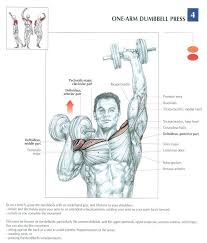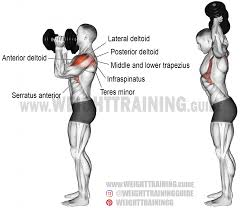Shoulder Press


Muscles at work during the overhead press
Standing overhead press
If you choose to do the overhead press from a standing position, you’ll work most of the large muscles in your upper body, including the:
Because being upright requires balance, you also recruit the muscles in your core, including your abdominals and lower back.
In an upright position, you compensate for balance changes during each phase of the overhead press and create stability through the spine to ensure a proper foundation for a loaded overhead movement, explains Brent Rader, DPT, physical therapist at The Centers for Advanced Orthopaedics.
In addition to the power from your upper body, your lower body helps assist when you push a weighted bar overhead.
Seated overhead press
If you perform the overhead press in a seated position with your back pressed against the back of a pad, strength and mobility coach Matt Pippin, CSCS says the core activation will go away. The shoulders and triceps will perform all of the work.
How to perform an overhead press
When executing any exercise that involves using weight, you need to understand the function and pattern of the movement before you hit the gym.
The overhead press is simply a movement in which resistance is pushed above the head. You can do this in a variety of ways, like by using:
- both hands simultaneously
- one hand at a time
- a single barbell held by both hands
- one free weight in each hand
Check your shoulder mobility
With this in mind, you also need to find out if you have the shoulder mobility, or range of movement, to perform the exercise safely.
To determine this, Pippin suggests performing the following test:
Grip and hold
For the standing barbell press, walk up to the bar and grab it slightly wider than shoulder-width apart with palms facing away from your body. Then follow these steps:
- Unrack the bar and step back. The bar should be resting in your hands right around your collarbone.
- To start the movement, brace your abs, squeeze your butt, tilt your head back, and drive the bar up toward the ceiling.
- Once the bar passes your forehead, return your head to neutral while locking your arms out overhead. At the top of the press, make sure your abs and glutes are still engaged and you’re not bending your lower back.
- Slowly lower the bar back down to your shoulders, tilting your head back to make room.
Keep your elbows in
By keeping your elbows either directly underneath your wrists or slightly more inward.
“This angle will allow for optimal force production. If the elbows flare out to the side, you’re losing leverage from which to push from.".
Use your abs and glutes, too
By keeping your glutes and abs engaged throughout the movement.
“This is your pillar of support from which to press. Losing this stability will make the bar shake and reduce the amount of weight that you can push".